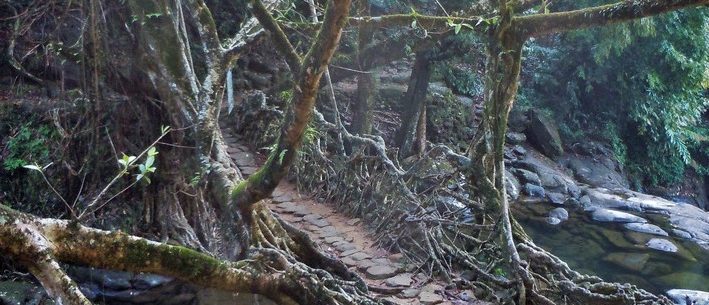A major attraction, the Living Root Bridges have existed in Meghalaya since 19th century CE. There are over 10 Living Root Bridges including 3-4 double decker bridge. There may be possibly more as many of the areas are not readily accessible. Most famous and most visited is the double decker bridge at Nongriat village.
Ingenious technique at work
The technique adopted by Khasi and Jaintia tribes is quite ingenious really. The roots of rubber fig trees, planted on one side of the river, are placed on hollow trunks of areca nut palm trees/bamboo that serves as a scaffolding across a river. The roots are nurtured until they grow till the opposite bank. They are then entrenched into the soil and fortified with pebbles and stones. It can take well over 15 years to reach the desired strength but can last for 500 years. They are believed to be strong enough to carry loads of over 50 people. The most amazing part of it all is that even if some roots die, new ones take their place.
To the naked eye, a Living Roots Bridge may be similar to the sights of tree trunks flung across small rivers in Indian villages for crossing. But it is the history and making of the bridge that is more fascinating than the bridge itself.
Double Decker Living Roots Bridge at Nongriat village, near Sohra
The most popular bridge is the Double Decker Living Roots bridge over Umshiang river at Nongriat village. From Sohra, drive for about 30 minutes to Tyrna village which is about 20kms away. The road may not be in a great condition. From Tyrna village, it is a arduous and beautiful trek amidst dense forest for 3 kms to Nongriat village. It is 3500+ steps down(over 2400 ft.) and can take an average of 60-90 minutes. Estimates of number of steps vary but that should not deter you.
The bridge itself has two decks, very much like a road cum rail bridge and is believed to be about 200 years old. The story is that the second level was built after it was noted that the river water would often submerge the first level!
Best part is there is tea stall at the village(serves ready to eat noodles also), as well as a fairly neat toilet. There is also a clear pond with small fish where you rest your tired feet.
The toughest part is the upward trek back to Tyrna village. This will take over 2 hours.
The path will be wet and slippery and it can rain anytime. Humidity is high. So dress accordingly. Carry some cash for paying a small entry fee and for refreshments.

Overall time
Overall, at least 6 hours are required from Cherrapunji. Early start is recommended. I am told the Double Decker Bridge is now closed on Sundays. So do check before you venture out.
Ritymmen living roots bridge
About half the way, there is single deck living roots bridge, Ritymmen at Nongthymmai village which is believed to be the longest at 100ft. The bridge at Nongriat is about 65ft.

There are basic homestays nearby
If you are the adventurous type, there are basic homestays near the bridge where you can stay overnight. But I do not know what kind of food is served. If you decide to stay, you can also trek to Rainbow falls. Lime juice is available on the way but if you are a bit finicky, carry your drinks. But given the nature of trek, the less you carry, the better it is.
Good to hire a guide
It may be good idea to hire a guide at Tyrna and hear from him the story behind the bridges. The guide will also carry your bags. But DIY is fine as well, With clear signages, you are unlikely to lose your way.
Umminoi living roots bridge
There is another single deck bridge about 3kms further down from Tyrna village near Laitkynsew village. Called Umminoi bridge, it is located at Nongkroh village. Starting point is at Laitkynsew village from where you have to go 1400 ft down and over 2kms.

Riwai living roots bridge
Another bridge is near Mawlynnong village, close to the Bangladesh border. The Living Root Bridge is near the village Riwai village, 1 km from Mawlynnong, from where it is about 15 minutes walk one way.
This bridge can be visited if Mawlynnong or Dawki is on your itinerary.

